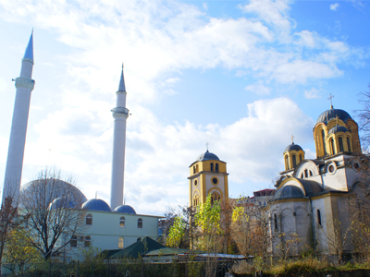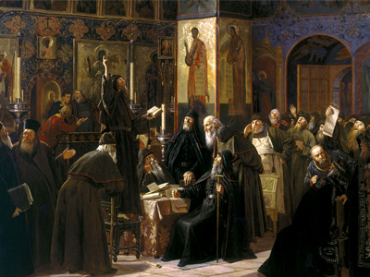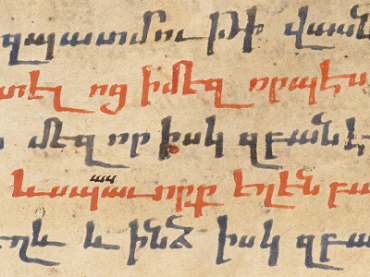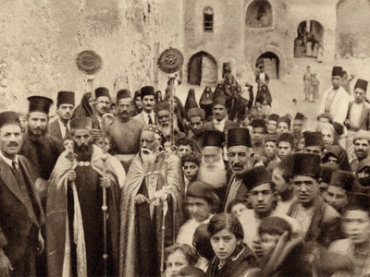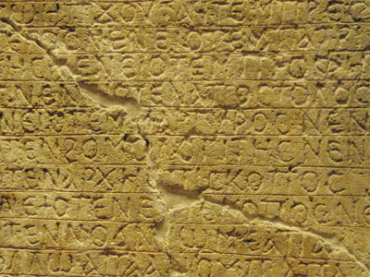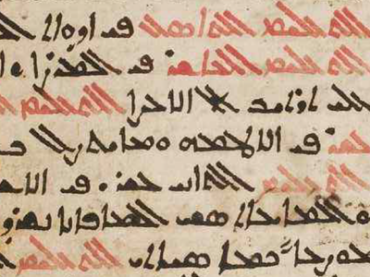Syriac and Eastern Christianity
Sermons on the Song of Songs, II
By Gilbert of Hoyland; Translated by Lawrence C. Braceland SJ
Series: Monastic Studies Series 22
ISBN: 978-1-60724-204-8
Taking up Saint Bernard's unfinished sermon-commentary, Gilbert ruminates on verse 3:1-5:10 in forty-eight sermons, leaving the task to be finished by John of Ford.
$165.00
The Letters, I
Series: Monastic Studies Series 27
ISBN: 978-1-60724-205-5
These are the letters of Adam of Perseigne, Spiritual director to kings and clerics, nuns and nobles and adviser to Richard the Lion-hearted; Adam also found favor at the witty court of the Countess of Champagne.
$166.00
The Art of Preaching
By Alan of Lille; Translation and Introduction by Gillian R. Evans
Series: Monastic Studies Series 28
ISBN: 978-1-60724-206-2
Preaching was a much admired, much studied, and much practiced art by both abbots and secular clergy. This handbook designed for training future preachers gives moderns an insight into the technique and the content of those twelfth-century sermons.
$158.00
Sermons on Conversion
By Bernard of Clairvaux; Translation and Introduction by Marie-Bernard Saïd
Series: Monastic Studies Series 29
ISBN: 978-1-60724-207-9
The burgundian reformer abbot draws a picture of the perfect frontier bishop, and holds him up as a model for bishops everywhere. Conversion is used here not in the modern sense of transferring from one ecclesiastical body to another, but in the patristic and monastic sense of metanoia, turning one's entire being wholly to God.
$178.00
Commentary on the Seven Catholic Epistles
Series: Monastic Studies Series 30
ISBN: 978-1-60724-208-6
Best known in the Middle Ages as a scriptural exegete, Bede here provides a running gloss on the Letters of James, Peter, John, and Jude. Why he chose these `lesser letters' for his first attempt at written exegesis no one knows; perhaps he did so because so few other scriptural commentators had glossed them. They are unique in that he inclined more to the literal interpretation of the text than he did in his more allegorical later commentaries. Preachers will find them useful; readers will find them illuminating.
$177.00
Homilies on the Gospels
Book One: Advent to Lent
By Bede the Venerable; Translated by Lawrence T. Martin & Dom David Hurst OSB; Preface by Sister Benedicta Ward SLG; Introduction by Lawrence T. Martin
Series: Monastic Studies Series 31
ISBN: 978-1-60724-209-3
From the eighth to the fifteenth centuries, Bede's authority as a scriptural exegete was second only to that of the Doctors of the Latin Church. Yet modern readers associate this remarkable scholar-monk only with his History of the English Church and Nation and ignore the works he saw as his chief accomplishment.
$154.00
The Spiritual Meadow
By John Moschos; Translation and Introduction by John Wortley
Series: Monastic Studies Series 32
ISBN: 978-1-60724-210-9
'I have plucked the finest flowers of the unmown meadow and worked them into a row which I now offer to you', wrote John Moschos as he began his tales of the holy men of seventh-century Palestine and Egypt. This translation offers readers contemporary insights into the spirituality of the desert.
$160.00
Handmaids of the Lord
Contemporary Descriptions of Feminine Asceticism in the First Six Christian Centuries
Edited and Translated by Joan M. Petersen
Series: Monastic Studies Series 33
ISBN: 978-1-60724-211-6
Throughout the Christian world, women have chosen to lead disciplined lives of prayer and asceticism. Descriptions of early role-models—Macrina, the two Paulas and Melanias, Radagunde—and others by contemporaries, usually men, provide details of their austerities, their aspirations, and their relationship with the Church and the world, not least with male authority figures.
$192.00
The Spirituality of the Medieval West
From the Eighth to the Twelfth Century
By André Vauchez; Translated by Colette Friedlander
Series: Monastic Studies Series 34
ISBN: 978-1-60724-212-3
Defining spirituality as 'the dynamic unity between the content of a faith and the way in which it is lived by historically determined human beings', Vauchez steps outside the clerical world usually studied to trace the religious mentality of the laity, the ordinary and often illiterate majority of Christians.
$129.00
The Celtic Monk
Rules and Writings of Early Irish Monks
Series: Monastic Studies Series 35
ISBN: 978-1-60724-213-0
In the Early Middle Ages, the irish temperament—individualistic, poetic, and deeply loyal to family—produced great and learned saints and a unique monastic literature. Before the Norman Invasion, the isolation of the island allowed the development of traditions quite different from those of the continent or Britain. The rules, maxims, litanies, and poems of early irish monks convey the spirituality of the Isle of Saints in the sixth to eighth centuries.
$166.00
Jacob of Sarug’s Homily on Simon Peter, when our Lord said ‘Get behind me, Satan’
Translation and Introduction by Adam Carter McCollum
Series: Texts from Christian Late Antiquity 26
ISBN: 978-1-60724-214-7
Jacob of Sarug's (d. 521) homily on Simon Peter, when our Lord said, “Get behind me Satan!” (Matt 16:23) touches the themes of Jesus’ divinity and death, warfare with Satan, the harrowing of hell, and his relationship with Peter. Peter’s rebuke of Jesus’ willingness to die gives Jesus (through Jacob) the occasion to explain what his death will accomplish. The volume constitutes a fascicle of The Metrical Homilies of Mar Jacob of Sarug, which, when complete, will contain the original Syriac text of Jacob's surviving sermons, fully vocalized, alongside an annotated English translation.
$33.00
Mount Sinai
A Modern Pilgrimage
Series: Kiraz Historic Travels Archive 22
ISBN: 978-1-60724-243-7
This timeless travelogue by noted hymnographer and missionary A. Mary R. Dobson recounts her journey to the manuscript-rich monastery of St. Catherine’s in the Sinai peninsula. Traveling with her cousin, Orientatlist Rendel Harris, Dobson wrote an account of her journey that still captures the imagination of modern day readers.
$124.00
Malphono Shukri Taraqji—His Life and Writings
ISBN: 978-1-60724-248-2
Shukri Taraqji (1911-1982) was an important figure in the Syriac literary revival of the twentieth century and this small volume collects a number of his writings into one convenient place. An introduction by Bishop Gregorios Yohanna Ibrahim provides an account of Taraqji’s life and activities, both professional and ecclesiastical. This volume will be of great interest to anyone interested in the contemporary history of Syrian Orthodox Christianity, Syriac, and Middle Eastern Christianity.
$118.00
Establishment – Development 1924-2004
By Sara Doghramji; Introduction by Gregorios Yohanna Ibrahim
ISBN: 978-1-60724-249-9
After the expulsion of the Syrian Orthodox community from Edessa in 1924, they found refuge in Aleppo. One of the first things the community did upon its settling in Aleppo was found a school where its youth were taught the Syriac language and important melodies and prayers from the liturgy, among other things. This school was the ancestor of the Syrian Orthodox school of Aleppo which is today called by the name of Bani Taghlib, and in this book Sara Doghramji has given us a history of this institution, from its founding in 1927 to the present.
$171.00
The Aramaic Influence in the Vernacular of Sadad
By Fadel M. Mubaraka; Edited with an Introduction by Gregorios Yohanna Ibrahim
ISBN: 978-1-60724-250-5
Fadel Mubaraka has here given us a study of the linguistic survivals of Aramaic in the Arabic dialect of the town of Sadad, in Syria, home to a large Syrian Orthodox community. Arranged alphabetically in the style of a dictionary, Mubaraka lists hundreds of different Arabic words, defines them, and then discusses their Aramaic etymology. Although the focus is on the specific dialect of Sadad, Mubaraka’s work and the words he discusses are not necessarily only to be found in this one location. This work will therefore be of great value to all interested in Arabic dialectology, the Aramaic influence on colloquial Arabic, and in the cultural history of the Levant.
$239.00
Catalogue of the Syriac Manuscripts in St. Mark’s Monastery
By Yuhanna Dolabani; Edited with an Introduction by Gregorios Yohanna Ibrahim
ISBN: 978-1-60724-251-2
This book is a reproduction of Philoxenos Dolabani’s handwritten catalogue of the Syriac, Karshuni, and Arabic manuscripts located in St. Mark’s Syrian Orthodox Monastery in Jerusalem, one of the most important Christian manuscript collections in the Middle East.
$218.00
Catalogue of Syriac Manuscripts in Za‘faran Monastery
By Yuhanna Dolabani; Edited with an Introduction by Gregorios Yohanna Ibrahim
ISBN: 978-1-60724-252-9
This book is a reproduction of Philoxenos Dolabani’s handwritten catalog of the manuscripts contained at Dayr al-Za‘faran. Dolabani was one of the greatest scholars of Syriac in the twentieth century and he made the catalogue while still a monk. This work, two volumes combined under one cover, is an important resource for all interested in Syriac and Christian Arabic.
$283.00
Papyri and Leather Manuscripts of The Odes of Solomon
Edited by James H. Charlesworth
ISBN: 978-1-60724-258-1
The Odes of Solomon, pseudepigraphically attributed to the son of David, are forty-two odes or hymns that date from the earliest periods of Christianity. No extant manuscript preserves a complete copy of these odes; portions, however, are preserved in one Greek papyrus, one leather Coptic manuscript, one leather and one paper Syriac manuscript. This edition presents facsimiles of these original documents, giving scholars direct access to this early Christian literary work.
$219.00
Catalogue of Syriac Manuscripts in Syrian Churches and Monasteries
By Yuhanna Dolabani; Edited with an Introduction by Gregorios Yohanna Ibrahim
ISBN: 978-1-60724-259-8
This book is a collection of a number of small catalogues and hand-lists of manuscripts held in the possession of Syrian Orthodox churches, monasteries, and even individuals throughout the Middle East. The eminent scholar and bishop, Philoxenos Dolabani, carried out the enormous task of cataloguing and describing these little-known and difficult-to-access collections.
$203.00
Lamp of the Sanctuary by Mar Gregorios Yohanna Bar Ebroyo Maphryono D-Madnho
Translated by Dionisios Behnam Jijawi; Introduction by Gregorios Yohanna Ibrahim
ISBN: 978-1-60724-260-4
The Lamp of the Sanctuary is the most important theological encyclopedia in the Syriac language and its author Gregory Bar Hebraeus was perhaps the greatest polymath ever to write in Syriac. The book is divided into twelve different sections which span the breadth of medieval theology.
$311.00
Wort und Wahrheit
Revue for Religion and Culture. Supplementary Issue Number 1. First non-official Ecumenical Consultation between Theologians of the Oriental Orthodox Churches and the Roman Catholic Church. Vienna-Lainz September 7-12 1971
Translated by Maurice Khuri Taraqji; Introduction by Gregorios Yohanna Ibrahim
ISBN: 978-1-60724-261-1
This is a translation into Arabic of Wort und Wahrheit: Revue for Religion and Culture, Supplementary Issue Number 1, which contained the papers and minutes of the first non-official ecumenical consultation between Oriental Orthodox and Roman Catholic theologians, sponsored by Pro Oriente, the ecumenical foundation. This volume contains a number of papers by Oriental Orthodox and Roman Catholic theologians relating to Christology, Monophysitism and Dyophysitism, and the acceptance of the Council of Chalcedon.
$198.00
Arabic-Syriac Dictionary
By Mikhael Murad; Edited by Gregorios Yohanna Ibrahim
ISBN: 978-1-60724-262-8
This book is a reprint of Murad’s Arabic-Syriac dictionary, the first such dictionary ever composed, and the only work of the author. The present volume extends from the letter alif to the beginning of the letter sin; the second half of the dictionary has unfortunately been lost. For each Arabic word given, a number of Syriac equivalents are recorded. The dictionary also gives Syriac equivalents to Arabic idioms.
$270.00
Accepting the Other
ISBN: 978-1-60724-263-5
Written by the eminent Syrian Orthodox Metropolitan of Aleppo, Accepting the Other, offers an eloquent and alternative perspective to the question of religious co-existence and the so-called ‘Clash of Civilizations.’ Bishop Gregorios’ book begins with an historical overview of the presence of Christians in the Middle East and their rich cultural contributions to the region, stretching back to the days of the Roman Empire and discusses the Islamic conquests and the Crusades from the little-heard yet extremely important Middle Eastern Christian perspective; he also offers examples of Christian-Muslim co-existence and discusses the question of citizenship.
$169.00
Syrian Orthodox Music
ISBN: 978-1-60724-264-2
This book originated in Bishop Yohanna Gregorios’ dissatisfaction with the lack of a study which would show where the music of the Syrian church came from, how it was accepted in the church, the basis on which it entered the church, the regional variation in chanting traditions, and the development of church music through time.
$127.00
the Vienna Dialogue
Five Pro Oriente Consultations with Oriental Orthodoxy. Communiqués and Joint Documents. Booklet Nr. 1
Translated by Michel Azraq; Edited by Gregorios Yohanna Ibrahim
ISBN: 978-1-60724-265-9
This book is a translation into Arabic of The Vienna dialogue: Five Pro Oriente consulations with oriental Orthodoxy: communiqés and common declarations, edited by Rudolf Kirchschläger and Alfred Stirnemann (Horn, Austria, 1991); it contains a number of documents written by both Roman Catholic and Oriental Orthodox churchmen connected to the question of the relationship between these churches.
$134.00
Filter by
Filter by price
Filter by manufacturer

